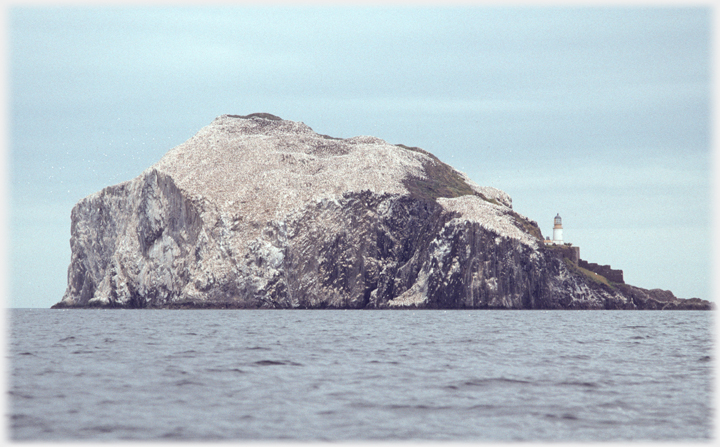 The Bass Rock from the south-west, turned white by the gannets (and their 'output')
This page is about the Bass Rock, a small volcanic island rising 300 feet (100 m) from the water, on the east coast of Scotland, where the Firth of Forth joins the North Sea. It lies about a mile from the shore near North Berwick, and some 30 miles (48 kms) east of Edinburgh. Its glory is that it is home to the world's largest colony of North Atlantic Gannets, numbers of which can rise to around 150,000. The screaming wheeling seething mass overhead, joins the smell of the guano which, together with the motion of the
small boat needed for the trip, creates a unique experience - one that still photography cannot capture, although hopefully the photos do show something of the birds themselves. One of their most magnificent performances is given when they dive into the sea after fish. Photographs illustrating this were taken in the south-west of Scotland, the activity can be seen almost anywhere around the British islands as the birds travel up to 200 miles (320 kilometres) in search of food from one of the 21 gannetries around our coastlines.
The Bass Rock from the south-west, turned white by the gannets (and their 'output')
This page is about the Bass Rock, a small volcanic island rising 300 feet (100 m) from the water, on the east coast of Scotland, where the Firth of Forth joins the North Sea. It lies about a mile from the shore near North Berwick, and some 30 miles (48 kms) east of Edinburgh. Its glory is that it is home to the world's largest colony of North Atlantic Gannets, numbers of which can rise to around 150,000. The screaming wheeling seething mass overhead, joins the smell of the guano which, together with the motion of the
small boat needed for the trip, creates a unique experience - one that still photography cannot capture, although hopefully the photos do show something of the birds themselves. One of their most magnificent performances is given when they dive into the sea after fish. Photographs illustrating this were taken in the south-west of Scotland, the activity can be seen almost anywhere around the British islands as the birds travel up to 200 miles (320 kilometres) in search of food from one of the 21 gannetries around our coastlines.
 From the west side of Edinburgh (The spires of the Anglican Cathedral are to the right) the volcanoes of East Lothian can just be seen - North Berwick Law is central, the Bass Rock to its left
From the west side of Edinburgh (The spires of the Anglican Cathedral are to the right) the volcanoes of East Lothian can just be seen - North Berwick Law is central, the Bass Rock to its left
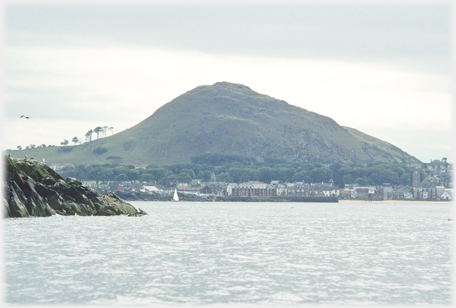 Looking back, en route to the Rock, at North Berwick Law
Looking back, en route to the Rock, at North Berwick Law
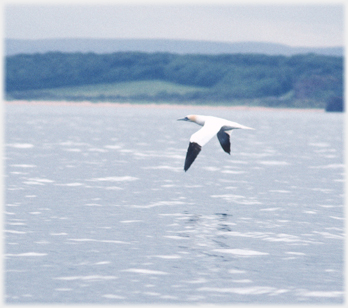 The passing gannet's smooth majestic flight
The passing gannet's smooth majestic flight
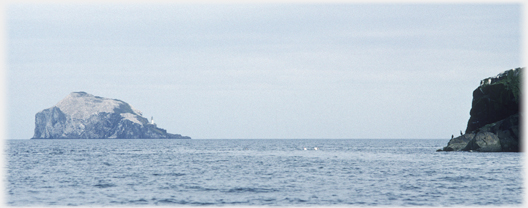 The Rock is not far off shore, within view of these cormorants sitting on the landward rocks
The Rock is not far off shore, within view of these cormorants sitting on the landward rocks
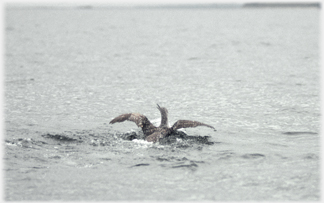 Stately once flying, but getting out of the water for a young bird is no easy matter!
Stately once flying, but getting out of the water for a young bird is no easy matter!
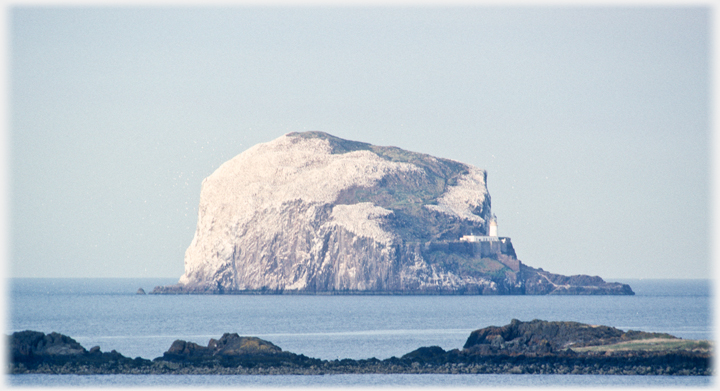 The evening sun makes the conversion of black volcanic rock to a white (guano) Christmas cake all the more conspicuous
The evening sun makes the conversion of black volcanic rock to a white (guano) Christmas cake all the more conspicuous
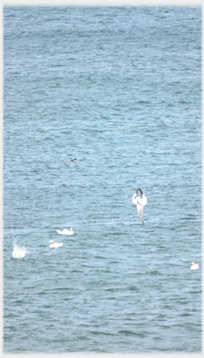 Birds enter the water at nearly 50 mph (80 kph)...
Birds enter the water at nearly 50 mph (80 kph)...
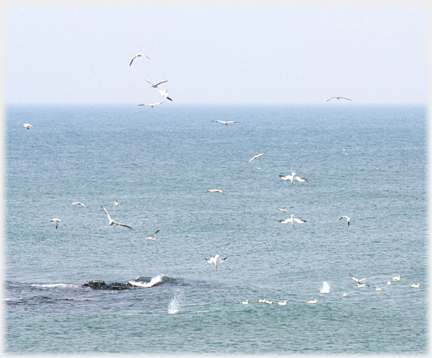 ...These speeds would break the necks of human divers...
...These speeds would break the necks of human divers...
These photographs of wheeling and diving gannets, were taken off Corsewall Point, in south-west Scotland
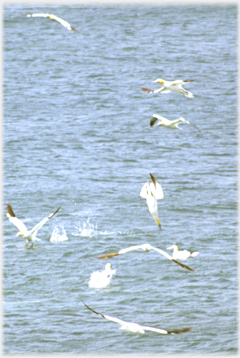 ...The wings are folded right back to the tail
...The wings are folded right back to the tail
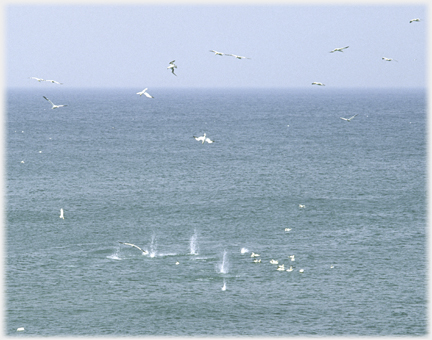 The birds wait overhead, when shoals of fish are detected. The splashes of recent dives can be seen
The birds wait overhead, when shoals of fish are detected. The splashes of recent dives can be seen
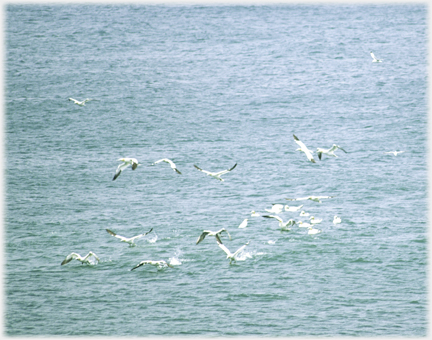 On emerging from the water the birds have the effort of getting their three kilogram bodies back up into the air
On emerging from the water the birds have the effort of getting their three kilogram bodies back up into the air
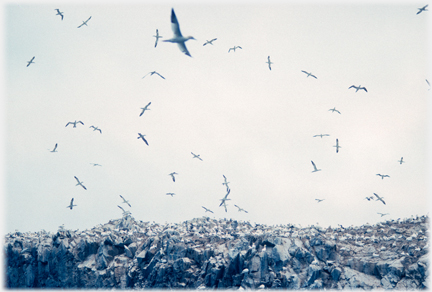 Back at the Bass Rock the birds wheel overhead...
Back at the Bass Rock the birds wheel overhead...
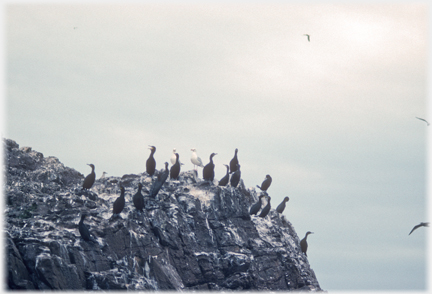 ...but of course other species (cormorants) get a foothold
...but of course other species (cormorants) get a foothold
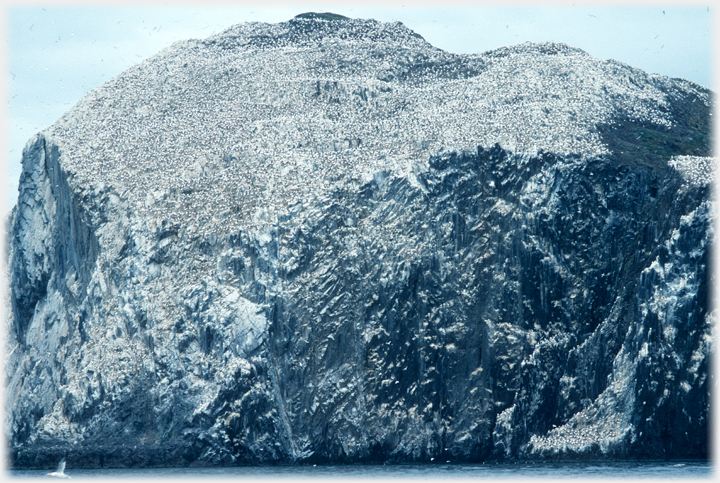 At this magnification, the gannets (each about one yard by two yards when flying - 0.9 by 1.8 metres) become just white dots
At this magnification, the gannets (each about one yard by two yards when flying - 0.9 by 1.8 metres) become just white dots
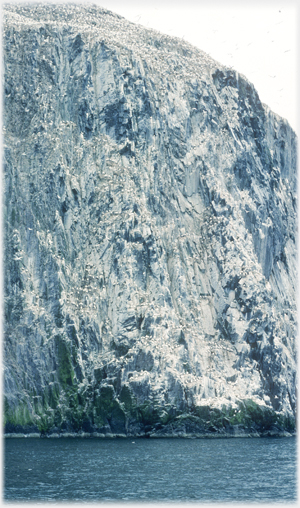 The west cliffs offer a myriad of...
The west cliffs offer a myriad of...
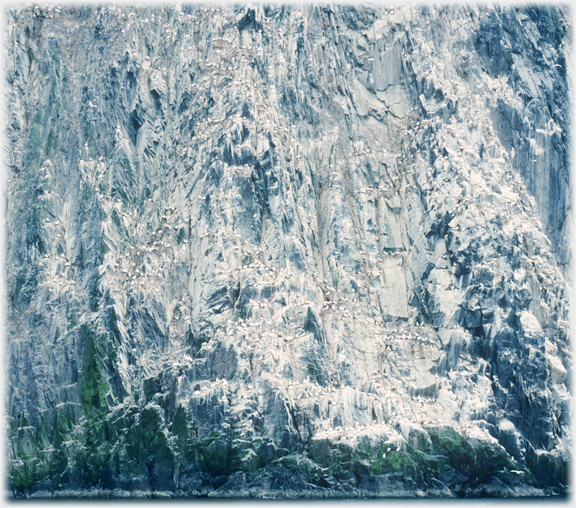 ...ledges and crevices where the birds can nest
...ledges and crevices where the birds can nest
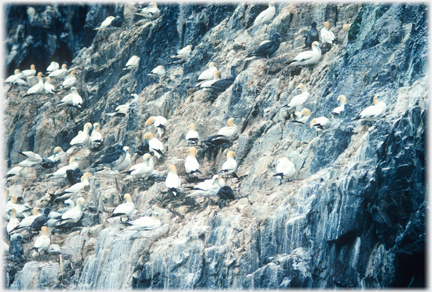 Coming closer to the cliffs when the beautiful...
Coming closer to the cliffs when the beautiful...
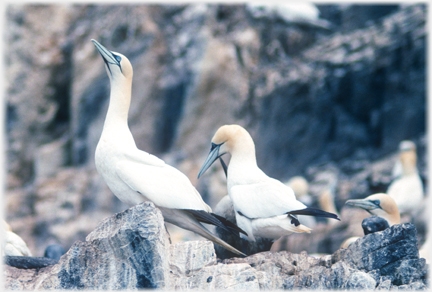 ...soft brown on the back of the heads can be seen
...soft brown on the back of the heads can be seen
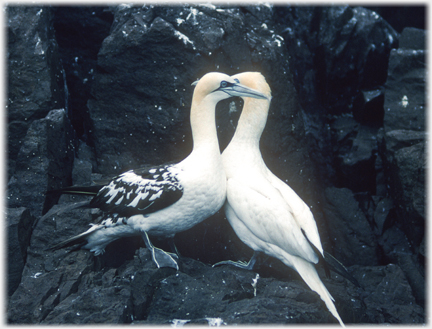 A 'sub-adult' bird gently nestling against a probable parent
A 'sub-adult' bird gently nestling against a probable parent
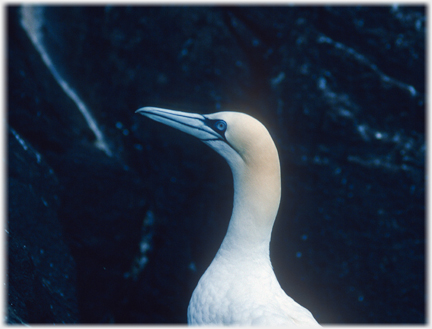 The full adult seeming to be more a work of fine porcelain
The full adult seeming to be more a work of fine porcelain
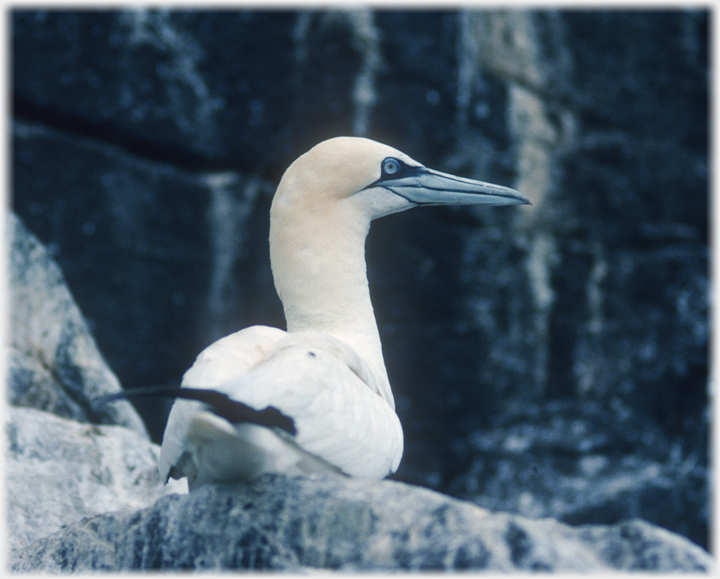 Poser. For us the delicacy of the blue eye, soft brown head and black lines marking the beak are aesthetic. And for a fish about to be speared by that massive beak?
Below some photographs of nestlings
Poser. For us the delicacy of the blue eye, soft brown head and black lines marking the beak are aesthetic. And for a fish about to be speared by that massive beak?
Below some photographs of nestlings
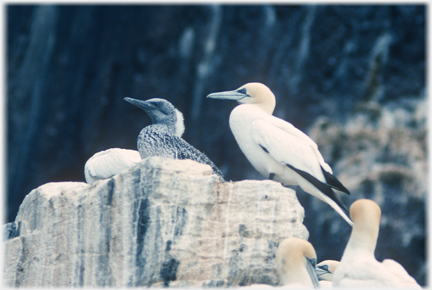
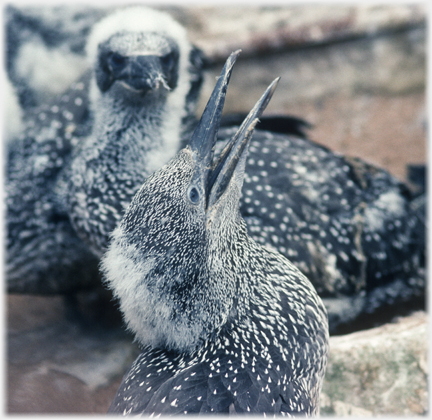 A bird now with little down - practicing trumpeting.
A bird now with little down - practicing trumpeting.
These pictures show nestlings at different ages. The birds above have little down left on their heads and necks; lower left, a full crown of down, and below an almost white bird
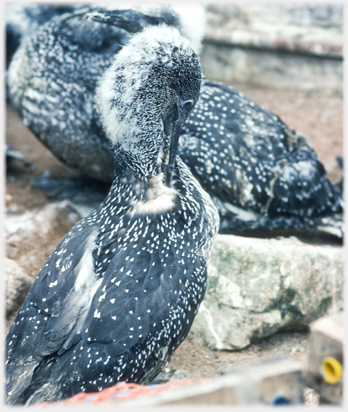 Above, a young bird - it still has down on the back of its neck - next to parent. The elder bird is very relaxed - neck right down
Above, a young bird - it still has down on the back of its neck - next to parent. The elder bird is very relaxed - neck right down
Left a young bird tackling the problem of preening under the chin
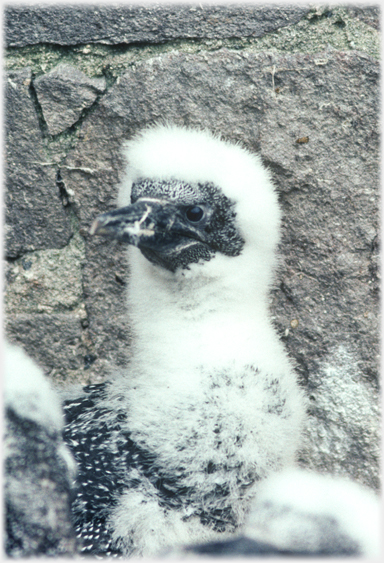 The bird below is younger with plenty of down on the crown and back of the neck
The bird below is younger with plenty of down on the crown and back of the neck
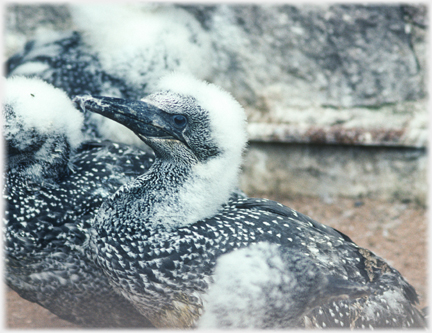
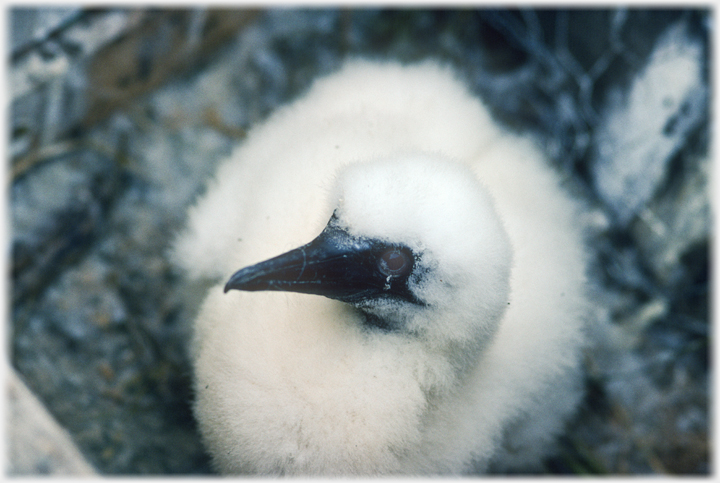 What parent couldn't be proud of me?
Trailers...
What parent couldn't be proud of me?
Trailers...
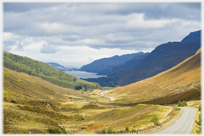 The next page
of this section takes you up to the highlands of Scotland and to the road to Gairloch in Wester Ross.
The next page
of this section takes you up to the highlands of Scotland and to the road to Gairloch in Wester Ross.
 The next page
of the Mosaic Section is headed 'Metaphor as Image'.
The next page
of the Mosaic Section is headed 'Metaphor as Image'.
Or go to the contents Go to the contents of the Mosaic Section. of the Mosaic Section.

 The last page had views of the Edinburgh skyline
The last page had views of the Edinburgh skyline
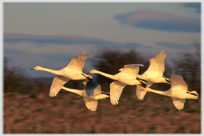 A page with photographs from two bird reserves in southern Scotland
A page with photographs from two bird reserves in southern Scotland
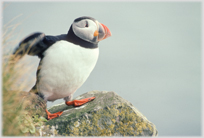 A page with birds from the cliffs of Iceland
A page with birds from the cliffs of Iceland
 ...guide to this site
...guide to this site